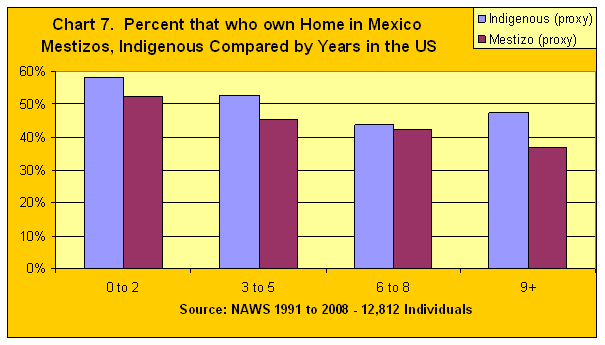Inequity
The indigenous are at a disadvantage both in Mexico and the United States
Why are the indigenous in California poorer than mestizos?
Measures of the disadvantages in the United States
Those able to stay for years in agriculture see improvement in status
Lives for indigenous as a group has not improved
Indigenous find less work and suffer worse conditions than mestizos
Strong ties to Mexico affect acquisition of U.S. assets
The indigenous are at a disadvantage both in Mexico and the United States
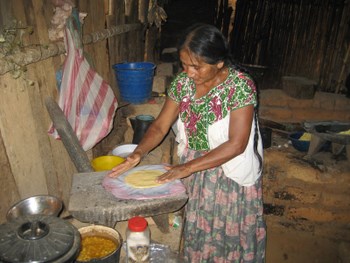 A woman in San Juan Piñas preparing a "tlayuda," a Oaxacan-style tortilla. Many of her relatives work in Santa Maria, California. Photo by Sandra Nichols.
A woman in San Juan Piñas preparing a "tlayuda," a Oaxacan-style tortilla. Many of her relatives work in Santa Maria, California. Photo by Sandra Nichols.On average, the indigenous people living in Mexico are poorer, less educated, and have higher infant mortality rates than the mestizo Mexican population. There are several factors that account for this. First, though many thousands of indigenous have migrated to the large urban centers in Mexico, and to areas near the border with the United States, most still live in remote villages and towns with few services. Another contributor to their disadvantaged status is the historical discrimination they endured at the hands of colonial and Mexican governments, and the continuing discrimination they face from Mexico’s mestizo population today. As a group, they have been intentionally deprived of employment and educational opportunities and public services proportionate to their share of the population. Lower levels of health, education and income for the indigenous, as compared to the mestizos, also persist in large Mexican cities, in the Mexican border areas, and in California.
The relative status of the indigenous does not improve when they come to the United States. The indigenous compared to the mestizos who work in California agriculture have lower incomes and worse working conditions, fewer assets, speak less English (and Spanish), and are more frequently separated from their family residing in Mexico.
Why are the indigenous in California poorer than mestizos?
As stated above the indigenous are a poorer group in Mexico even before they arrive in the United States. But, in addition, compared to the mestizos, the indigenous farmworkers are a more recently-arrived (newcomer) group than the more established mestizo Mexican immigrants. This status of new arrivals in large part explains their poverty.
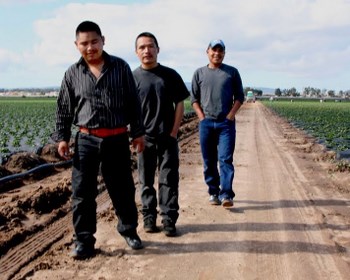 These young Zapotec farm workers walk out of a field in Santa Maria after having asked the foreman of a crew picking strawberries if there was any work for them. Photo copyright David Bacon
These young Zapotec farm workers walk out of a field in Santa Maria after having asked the foreman of a crew picking strawberries if there was any work for them. Photo copyright David BaconFarmworkers of both groups are on average quite young when they first cross the border. The typical age of first crossing the border for both groups is about 20 years old. However, the mestizos in the United States are much older on average since they have been here much longer. Notice in Chart 1 that at the same time that the age of the typical mestizo farmworker is increasing (somewhat) over these years, the age of the typical indigenous farmworker is not. The average age of an indigenous in recent years (2006 to 2008) has been about 25; while for the mestizos, the average is closer to 35.
[For a discussion of the methods used to compare mestizo and indigenous workers in the National Agricultural Workers using South and the Rest of Mexico as proxies survey data, see IFS Final Report, p. 16]
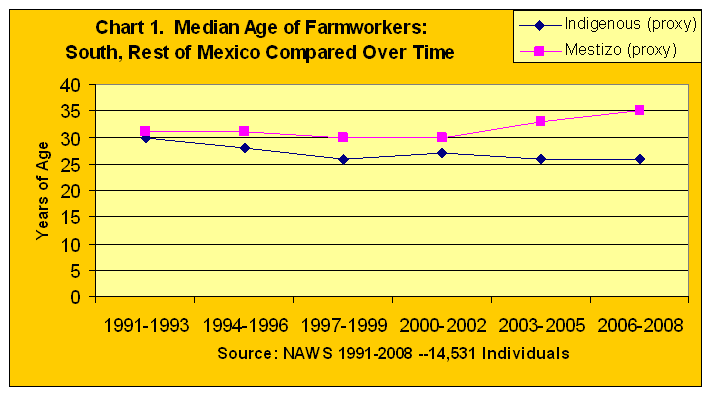
 A young Mixtec from Miahuatlan, Oaxaca picks weeds by hand in a carrot field in the Salinas Valley. Photo copyright David Bacon
A young Mixtec from Miahuatlan, Oaxaca picks weeds by hand in a carrot field in the Salinas Valley. Photo copyright David BaconAgain, why are the indigenous younger? This is true because many more of the indigenous have just recently arrived north of the border than the mestizos. This latter group has had time to age and gain experience in the United States. The typical indigenous person has been here only three years while the typical mestizo has been here for ten years. If you look at Chart 2 below, you will see that this difference between the two groups regarding the amount of time in the United States has actually expanded over time. In the 2006 to 2008 period for example, the typical years in the United States for an indigenous worker is only two years, while for a typical mestizo it is 11 years.
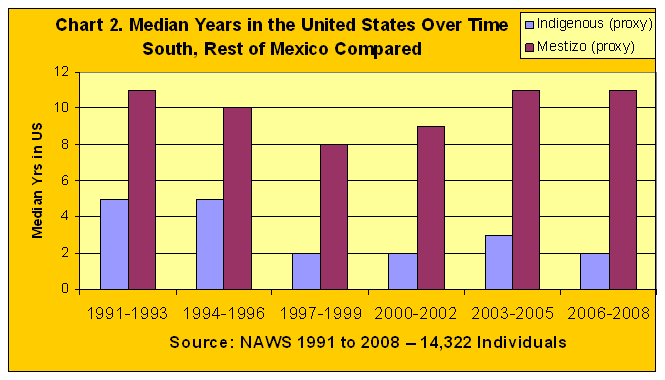
It is clear that the villages of origin of the indigenous (at least for those working in California agriculture) are on average much newer to international migration than mestizo villages. For this reason, the indigenous settlements are still composed of new, and young, arrivals while the mestizo hometowns with a long migratory history have a large proportion of settled veterans in the United States. Though there are plenty of newcomers continuously arriving from mestizo hometowns, the proportion of newcomers is much higher in the indigenous population.
Measures of the disadvantages in the United States
Their status as recent arrivals explains in large measure why the indigenous earn less, have fewer assets and are more likely to be separated from family. For example, the median family income in the 2006 to 2008 period was $13,750 for an indigenous family and $22,500 for a mestizo farmworker family. And being recently arrived means that the indigenous own fewer cars and dwellings compared with the mestizos. For example, among married men accompanied by their families, only 13 percent of the indigenous own their dwelling while 29 percent of the Mexican mestizos do. This same disadvantage also applies to education and the ability to speak English. For example, the National Agricultural Workers Survey (NAWS) shows fewer years of school completed in Mexico for young indigenous than for young mestizos. Finally, the NAWS shows us how the indigenous are much more likely to suffer from the ‘disadvantage’ of family separation from their nuclear family back home than other Mexican immigrants. Among NAWS respondents, 64% of the married indigenous versus 51% of the married Mexican mestizo farmworkers have their spouses back home in Mexico.
Those able to stay for years in agriculture see improvement in status
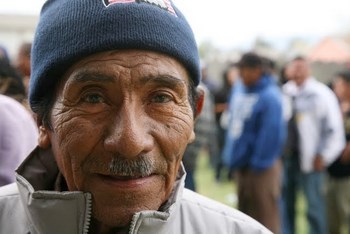 A Triqui farm worker in Greenfield, near Salinas. Greenfield is home to a large settlements of Triquis from Oaxaca. Photo copyright David Bacon
A Triqui farm worker in Greenfield, near Salinas. Greenfield is home to a large settlements of Triquis from Oaxaca. Photo copyright David BaconIndigenous farmworkers, like other farmworkers, who have figured out a way both to remain in the United States and continue doing farm work, see their conditions improve. But, since most of the long-stayers are mestizos, it is mostly they who benefit. The veteran indigenous (those with 9 years in California) do somewhat worse than veteran mestizos, but both see some improvement if they are able to carve out an existence as a California farmworker (see Chart 3, below). The personal income during the three year period (2006-2008) varied from about $10,000 a year for the newcomers to nearly $20,000 a year for the long-time committed farmworkers (with over 9 years in the United States).
The critical point to remember is that the indigenous (unlike their mestizo counterparts) are predominantly newcomers who haven’t had the chance to figure out how to improve their earnings. The bottom level jobs tend to be continuously filled with newly arriving indigenous while the better jobs are filled with mostly mestizos.
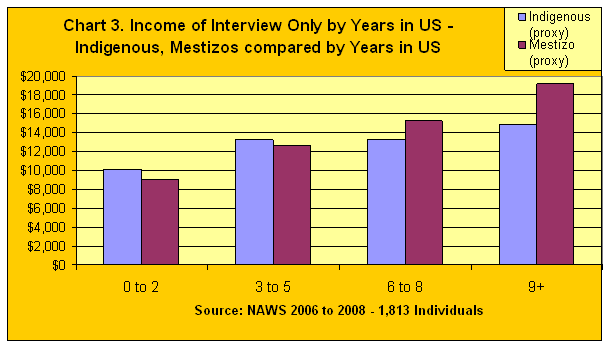
Lives for indigenous as a group has not improved
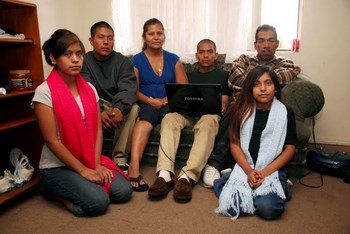 An indigenous Purepecha family from Turícuaro in the Mexican state of Michoacán. They live in Santa Paula, Ventura County and work in the strawberry fields. Photo copyright David Bacon
An indigenous Purepecha family from Turícuaro in the Mexican state of Michoacán. They live in Santa Paula, Ventura County and work in the strawberry fields. Photo copyright David BaconAlthough a large majority of indigenous farmworkers are newcomers, over time, a minority of individual indigenous farmworkers have managed to achieve a somewhat stable life style. For example, for the minority of the indigenous who have been here for nine years, most have a vehicle to drive, an indicator of some economic advancement. But, as a group compared to mestizos, the indigenous remain mired in precarious economic circumstances.
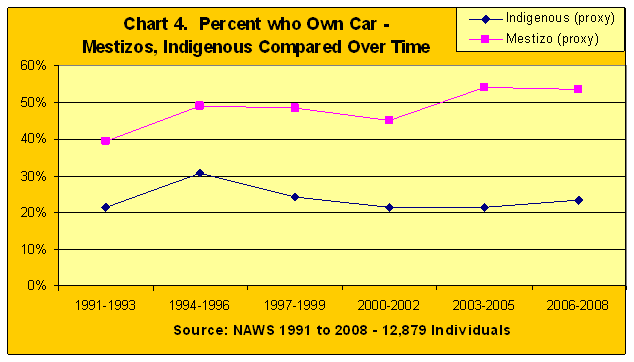
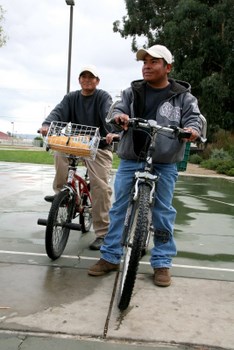 Few indigenous farm workers can afford to own cars. These young Mixtecs work picking strawberries near Santa Maria and use bicycles to get to work. Photo copyright David Bacon
Few indigenous farm workers can afford to own cars. These young Mixtecs work picking strawberries near Santa Maria and use bicycles to get to work. Photo copyright David BaconThe National Agricultural Workers Survey allows us to demonstrate clearly this stubborn relative poverty of indigenous as a group compared to mestizo farmworkers as a group. Chart 4 (above) shows that already in the early 1990s, about 40 percent of mestizos had a vehicle. Over time, the ability to obtain a car actually improved for mestizo workers observed as a group. In the more recent periods since 2003, the mestizo workers have maintained a rate of car ownership well above 50 percent. On the other hand, the indigenous have consistently had a low rate of car ownership. In fact, as a group, the indigenous have actually lost ground. In the 1994-1996 period, 30 percent had cars in the group, while throughout the decade after 2000 barely 20 percent have had cars.
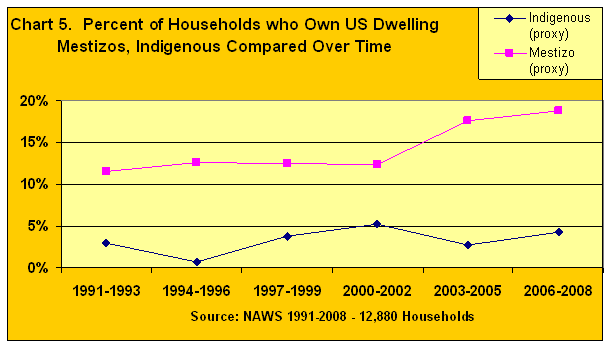
This same pattern of improvement for the group of mestizo farmworkers, compared to a stagnation among the indigenous, can also be observed in the acquisition of houses. Chart 5, above, shows that the indigenous, who have always had less than a five percent rate of home ownership, continue at a very low rate as a group. Meanwhile, the group of mestizo workers, who always had rates of ownership above 10 percent, has in recent years increased that proportion to almost 20 percent. The indigenous appear stuck at the bottom of the labor market and are less able than mestizos to adapt to U.S. society.
This relative disadvantage in cars and houses held by the indigenous as compared to the mestizos underlines the importance of measuring the assets held by different groups of farmworkers. Since wages per hour do not vary very much among farmworker groups, a comparison of assets is often a better way to measure the relative well being of different groups. And, these measures show that the indigenous are much worse off.Indigenous find less work and suffer worse conditions than mestizos
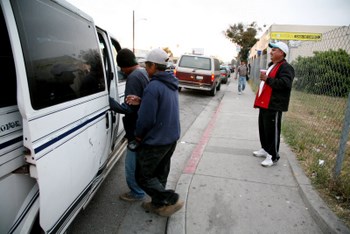 Many farm workers must pay a "ritero" or labor contractor for transportation to the fields. In Oxnard, indigenous migrants line the sidewalks in the early morning waiting for their ride to work. Photo copyright David Bacon
Many farm workers must pay a "ritero" or labor contractor for transportation to the fields. In Oxnard, indigenous migrants line the sidewalks in the early morning waiting for their ride to work. Photo copyright David BaconThe pattern of reward for experience also applies to wages and working conditions. The newcomers of both groups earned on average during the three years (2006 to 2008) about $7.50 an hour while the veteran workers with more than 9 years in the United States earned about $9.00 an hour. The wage per hour probably is not much lower for the indigenous than for mestizo farmworkers. Since the typical farmworker has difficulty working as many hours per year as he or she would like, the income of farmworkers is at least as much related to how many hours per year they work as it is to how much they earn per hour. The lower average incomes of the indigenous means that they are working fewer hours per year than the Mexican mestizo immigrants.
Although wages per hour may not be lower for the indigenous, working conditions probably are. One important gauge is whether the workers feel obliged to pay for rides to work. Many foremen take advantage of the most vulnerable among farmworkers by charging them to get to work. Chart 6 demonstrates again, the more entrenched farmworkers suffer from this practice much less than the newcomers. And the indigenous (in all the length-of-stay groups) have to put up with this practice much more than the mestizos. For the indigenous, the practice affects over 30 percent, even for those who have been here from 6 to 8 years. For the indigenous that have lived in the United States for more than 9 years, still 15 percent have to pay for rides from ‘raiteros’. The predominantly mestizo workers are much less exposed to this abuse. By the time they are experienced workers with 9 years or more in the country, only 5 percent are paying for rides.
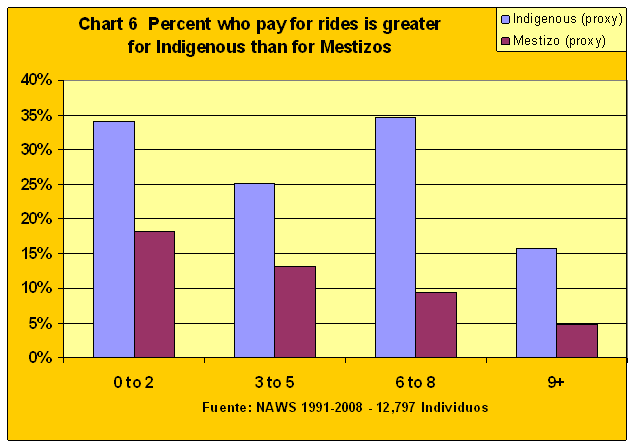
Strong ties back to Mexico affect acquisition of U.S. assets
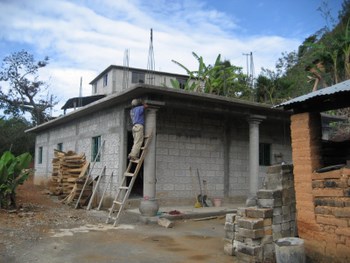 New home construction in San Juan Piñas, Oaxaca. Migrants working in California send money home to build their dream houses. Photo by Sandra Nichols.
New home construction in San Juan Piñas, Oaxaca. Migrants working in California send money home to build their dream houses. Photo by Sandra Nichols.One final observation helps explain why the indigenous have so few assets in the United States. The indigenous are more likely to use their limited resources to acquire and hold on to assets in Mexico than other Mexicans. And, this is true even for those indigenous who stay for long periods in the United States. Comparing the indigenous and mestizos who stay a long time in the United States, we find that the indigenous demonstrate more interest in maintaining homes in Mexico. In Chart 7, one can observe that for the indigenous, the proportion maintaining a home in Mexico does not decline as much as for the mestizos. For those indigenous who have been in the United States for 9 or more years, the rate of maintaining a house stays at a high level (48%) while for the mestizos the rate drops off to 37%. It may be that the indigenous are more likely to use their limited resources to maintain assets in Mexico because of a relatively stronger cultural bond to their hometown than the mestizos.
